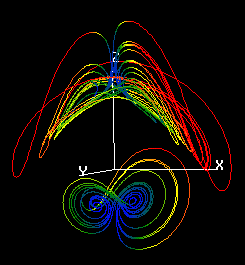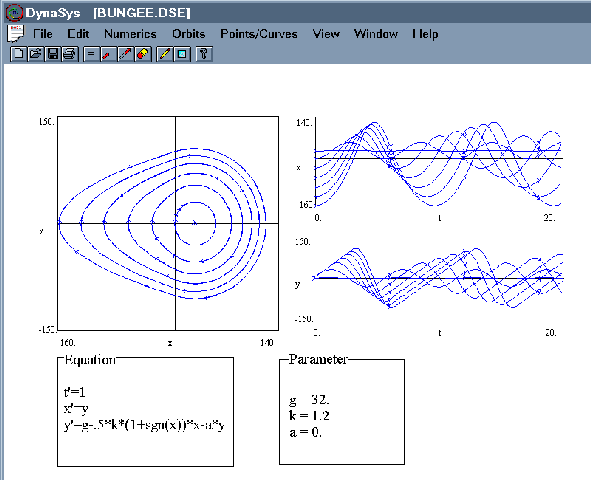

IDEA is a "virtual dynamic lab book" on the World Wide Web illustrating applications of differential equations in a wide variety of disciplines. Activities are being developed by us and contributions are being accepted from individuals at other institutions. IDEA provides users with internal and external tools to explore these activities mathematically.
The tremendous growth of the World Wide Web (WWW) in recent years has been prompted by individuals and groups wishing to share their message with a large audience at minimal cost. The increased use of the Internet has spawned equally astounding growth in the number of materials and tools available to Web site developers. From a mathematics education perspective, both of these factors provide us with new tools for the development of activities that demonstrate the utility and methods of mathematics to our students. The continually increasing number of WWW sites provides us with easy access to ideas and data from which we can develop material, and the development of new tools provides us with useful and exciting ways to disseminate our materials. In this paper we focus on the undergraduate differential equations curriculum and discuss one project that attempts to deliver these tools to instructors and students.
IDEA, or Internet Differential Equations Activities, is an NSF funded project whose goal is the development of an "interactive virtual lab book" for differential equations at the undergraduate level. The goals of IDEA are
Most of the exercises developed by us are based on our research interests and cover biology, chemistry, and ecology. Although not all exercises at IDEA are based on recent research (for example, we have one project exploring bungee jumping) we believe that the inclusion of projects developed from research activities gives the student an appreciation of differential equations not found in traditional texts.
We have taken a two-pronged approach to software development. We are developing the software DynaSys which will be available at the IDEA site. DynaSys is Microsoft Windows based software that allows users to input a system of ordinary differential equations and then to explore properties of the system numerically, using built-in tools. In addition to the generation of solution curves and phase portraits DynaSys allows the user to
Because almost every student has access to a personal computer (either their own or in a computing laboratory), we provide DynaSys free of charge to students and instructors. DynaSys is a flexible phase plotting software that can be used not only with IDEA exercises, but also with exercises appearing in the students textbook or developed by the instructor.
One of the most useful recent technical developments is the Java programming language. Java allows developers to include small programs, known as applets, within WWW documents. These programs allow Web users not only to retrieve information from the Web site, but to manipulate the document dynamically in ways that can be entertaining and educational. The second prong of software development is the development of Java applets for phase-plotting. These applets are tailored to the differential equations of the given exercise. Initial conditions are chosen by a simple mouse click on the phase portrait and the user has a limited ability to change parameters using simple menu options. An example of one of these applets is given in Section II. In order to facilitate the construction of Java applets by IDEA contributors we are currently developing a Java code generation package. This package will be available to prospective contributors over the Internet.
In the following sections we describe two ways to utilize IDEA materials and how prospective contributors can submit their materials to IDEA.
Users choosing the internal method complete the chosen exercise using only their web browser. The resources that allow this interaction are being developed using a combination of HTML and Java applets, small programs executable in Netscape 3.0 and other compatible web browsers. Hot-links are provided to a glossary of important terminology and other relevant information. Instructors need only provide their students with the URL of the exercise and the student can do the rest.
The bungee jumping exercise at IDEA illustrates the internal method. After a brief description of the problem, a simple model is constructed based on physical laws. The student is asked to analyze this model and answer questions using numerical and analytical calculations. The model is then adjusted to reflect more realistic hypotheses and additional questions are posed to the student. A key tool in the exploration of the model is the use of Java applets for numerical exploration. Below is an example of an applet used in this project. The graph on the right gives x vs. x' while the graphs on the right display t vs. x and t vs. x' respectively. For more information on this project and the associated model click here.
Initial conditions are chosen by clicking the mouse on the desired starting value in any of graphing windows. Clicking in the x vs. x' phase-portrait is best since this allows the user to specify both the initial position and initial velocity. Trajectories can be cleared from the screen using the Clear button on the bottom right of the applet frame. The three parameters in this model can be changed using a combination of the up and down arrows at the left of the screen. The first pair of arrows cycles through the three parameters and the second pair increases or decreases the value of the chosen parameter.
|
|
As part of the IDEA program, we are developing the phase plane analysis software DynaSys. DynaSys will be available from the IDEA web site and will be the only supported software on the site. A user choosing the external method will down-load a DynaSys template file by clicking on the appropriate icon in his/her web browser. The template file will contain the necessary differential equation information to be read into DynaSys so that the user can begin the exercise without any cumbersome set-up procedure. Lab instructions can either be down-loaded and printed or be viewed in the web browser. The advantage of this latter matter is that students will have access to hot-links providing glossary information and other relevant information. Thus both directions and instructional material will be available to the user on-line.

IDEA is to be more than a repository for a small collection of computer activities. It will be an evolving "virtual text" with new applications and activities continually being incorporated. To do this we need your help. We are looking for submissions from people who are developing interesting activities and people willing to evaluate our material and the material submitted by others. To facilitate the development of modules by outside contributors we have developed a Java code generation package to be made available to the general public over the WWW. The module author can create Java applets to accompany his/her project simply by providing the differential equations and other relevant information to the code generator. The software then takes this information and creates the desired applet to be included in the developers project.
If you have a project that you would like to submit to IDEA or would like to be part of the evaluation process we would love to hear from you. Send a brief abstract to Tom LoFaro at (lofaro@trout.math.wsu.edu) or by mail to
Thomas LoFaro Department of Pure and Applied Mathematics Washington State University Pullman, WA 99164-3113 (509) 335-3124 Fax: (509) 335-1188
![]() This
work funded by a grant from the National
Science Foundation.
This
work funded by a grant from the National
Science Foundation.
Windows and Windows 95 are trademarks of the Microsoft Corporation. Java is a trademark of Sun Microsystems. Netscape is at trademark of the Netscape Communications Corporation.
Copyright © 1996 Thomas LoFaro and Kevin Cooper
Wed Nov 6:10:07 PDT 1996